IAC News
IAC News No.113, March 2022
Japan Society of Civil Engineers International Activities Center March 1, 2022 IAC News No.113
The 23rd International Summer Symposium
The JSCE Annual Meeting of September 2021 was once again held online due to the spread of COVID-19. Following suit, the International Summer Symposium was also held online, taking place from September 9 to the morning of September 10. The International Workshop for Young Civil Engineers, which was unfortunately canceled last year, was held on September 10 as the first time in the workshop’s history that it has been held online.
The International Activities Center & International Student Network Group has held the International Summer Symposium since 2012. The symposium helps support both international students studying in Japan and native Japanese students present their research in English. The 23rd symposium was made up of sessions based on fields such as geotechnical engineering, earthquake engineering, structural engineering, disaster prevention and resilience, emerging technology, and the environment and materials. A total of 41 papers were presented.
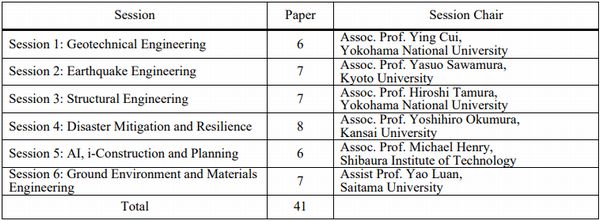
Last year, the presentation materials were published online and those who accessed the materials gave their thoughts via a bulletin board. This time, however, the presentations were made online using Zoom. Although they were virtual presentations, the speakers presented as if they were speaking face-to-face with their audience and engaged in passionate Q&A sessions with those watching.
This symposium was followed by the International Workshop for Young Civil Engineers held from 14:00 to 16:50 on September 10. This year, the participants shared their ideas for utilizing AI on the subject of “Utilization of AI in Civil Engineering for a Future Society.” This workshop was scheduled to be held last year, but it was canceled due to the impact of the coronavirus pandemic. The International Student Network Group continued to pay thought to the workshop and they pushed hard to make the event happen.
On the day, the workshop was facilitated by Associate Professor Yoshihiro Okumura of Kansai University, and at the beginning, Associate Professor Pang-jo Chun of the University of Tokyo gave a talk on basic knowledge about AI and introduced specific examples where AI has been implemented and utilized. Next, using Zoom’s Breakout Room feature, participants were split into groups according to the four topics of hydraulics (Assistant Professor Chandra Shekhar Goit of Saitama University), ground (Associate Professor Yasuo Sawamura), construction (Associate Professor Michael Henry), and disaster prevention (Associate Professor Takafumi Kitaoka of Kansai University) before holding discussions.
Although there were fewer participants than planned on the day, the participants were able to get a good look at who else was taking part as well as freely discuss what each other thought. At the end of the workshop, each group presented their ideas. Despite having limited time available, the participants seemed to have successfully advanced the discussion and examined the topic. This resulted in interesting and feasible ideas.
The International Student Network Group will hold an International Summer Symposium at the JSCE Annual Meeting in 2022 as well. In 2022, the theme of the International Workshop for Young Civil Engineers is set to be “Future Civil Engineering with AI and DX.” I hope that many international students and native Japanese students will present their research at the International Summer Symposium and will also participate in the workshop in 2022.
To close, I would like to take this opportunity to express my sincere gratitude to everyone who helped to make the International Summer Symposium a success.
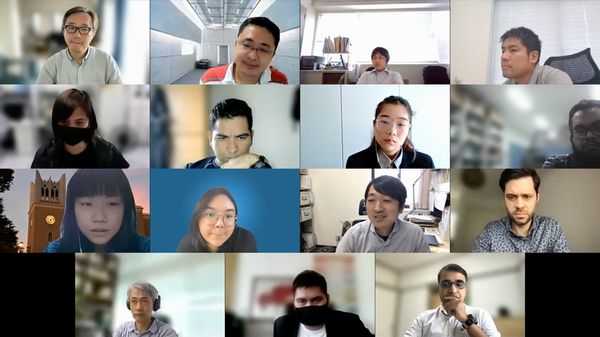
FY2021 The International Workshop for Young Civil Engineers“Utilization of
AI in Civil Engineering for a Future Society”
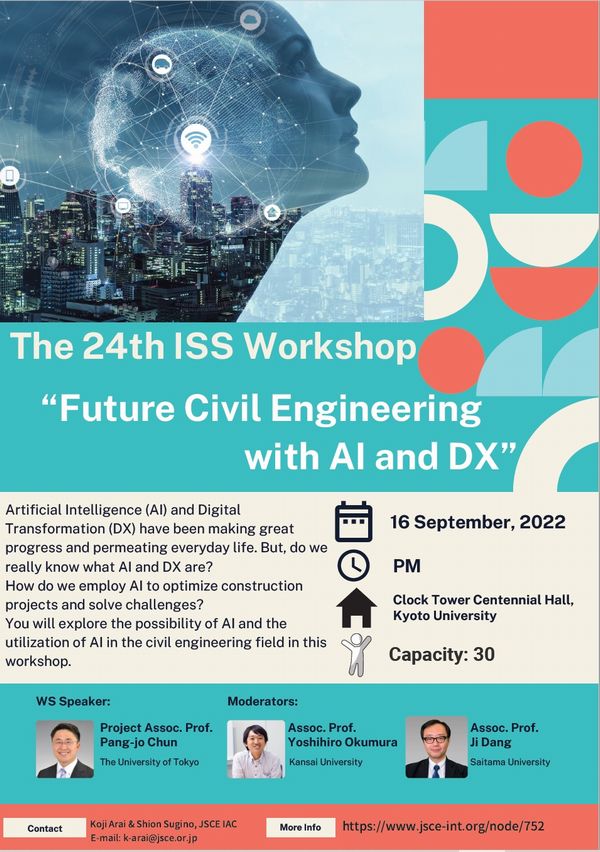
Future Civil Engineering with AI and DX
【Reported by Ji Dang, International Student Network Group, IAC (Saitama University)】
Evolving Construction Robots
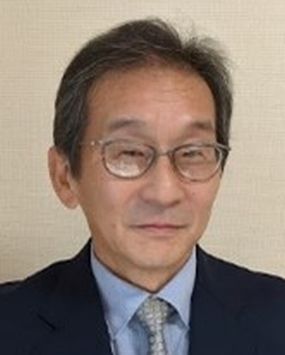 Kazuyoshi Tateyama
Kazuyoshi Tateyama
(Chair of Robotics Committee in Construction)
The research and development of construction robots are suddenly making rapid progress. The introduction of automation in the construction field is said to be 20 to 30 years behind the manufacturing industry, which has introduced automation technology called factory automation (FA) to production lines since the latter half of the 1970s, rapidly improving productivity in the industry. One of the major reasons behind this is that there are many uncertainties in the construction field. In other words, it is because machines must possess the autonomy to grasp the situation at construction sites and work while responding appropriately to each set of circumstances under conditions such as the diversity of infrastructure and so on subject to construction work, ever-evolving construction site conditions, and transportation work at expansive construction sites. For this purpose, using the unmanned construction system introduced to prevent secondary disasters in the disaster recovery work at Mount Unzen’s Fugendake, which started in the 1990s, system operators, located a safe distance away from the hazardous work area, remotely controlled heavy machinery to carry out the erosion control construction work by accessing the situation at the construction site and deciding how to respond via the system monitors. This was followed by the introduction of Global Navigation Satellite Systems (GNSS) and Machine Control (MC) technology, which automates part of the operation of construction machinery, taking further strides forward. As a result, unmanned construction technology gradually evolved. The outcome of this series of efforts is that it is now possible to remotely control heavy machinery in operation at construction sites several hundred kilometers away. Photo 1 shows a student remotely operating heavy machinery located at a construction site in Noda City, Chiba Prefecture from a university campus in Kusatsu City, Shiga Prefecture, as part of his education. With the rise in remote work due to the coronavirus pandemic, we are entering an era in which work using heavy machinery can also be done remotely.
Furthermore, in recent years, with the widespread popularizing of artificial intelligence (AI), it is fair to say that the development of construction robots has entered a new phase. This is because the introduction of AI has greatly increased the potential of autonomous work in which construction machinery grasps the situation at the construction site and decides the appropriate operation method on its own accord. Figure 1 shows the evolution process of construction robots, meanwhile Photo 2 shows an example of an autonomous construction robot system installed at a construction site. An autonomous construction robot system has already been introduced on a trial basis at the likes of dam construction sites, and while the practical application of this system continues to be verified, consideration is now being given to its use in lunar base construction in collaboration with the Japan Aerospace Exploration Agency (JAXA).
In consideration of the rapidly progressing decline in the working-age population, the Robotics Committee in Construction aims to build a system that makes it easy to introduce construction robots not only in efforts to respond to disasters but also in general construction work, with the goal of promoting the widespread adoption of construction robots. The committee has begun discussions on reducing development costs by sharing basic technologies and relaxing safety restrictions in the adoption of construction robots at construction sites. In my mind’s eye, I can see various construction robots up and running at construction sites in the near future.
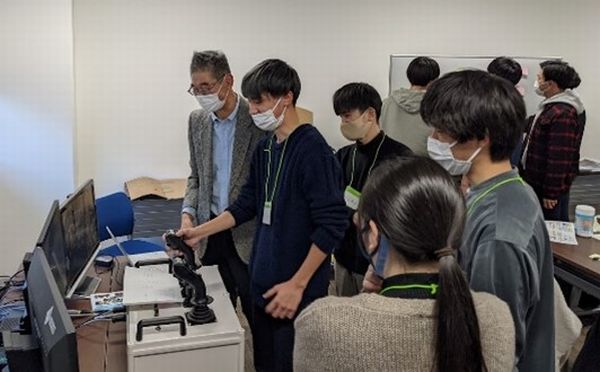
Photo 1 Unmanned Construction through Long-Distance Remote Operation
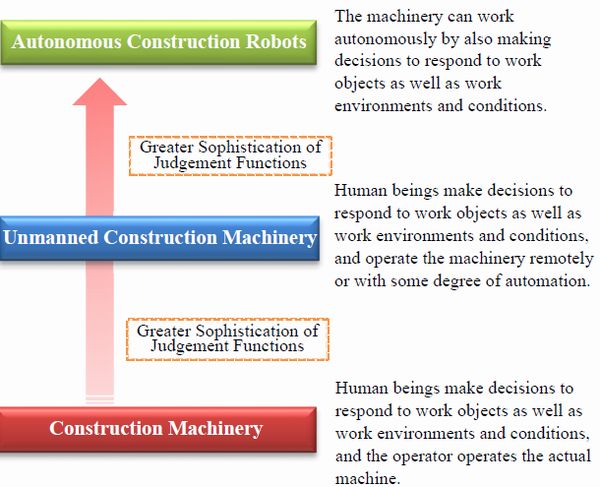
Figure 1 Gradual Evolution of Construction Robots
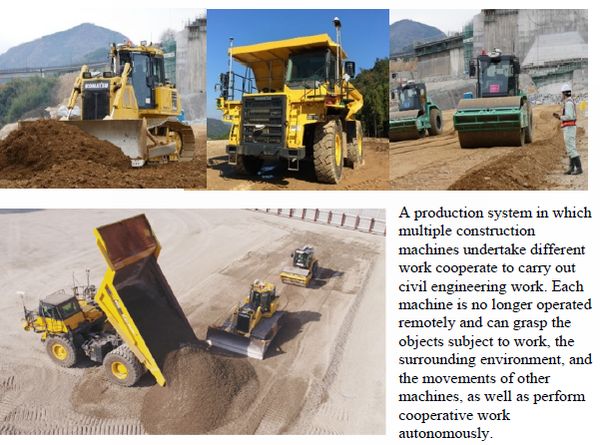
Photo 2 Example of Autonomous Construction Robot (A4CSEL of Kajima Corporation)
【Reported by Kazuyoshi Tateyama, Chair of Robotics Committee in Construction (Ritsumeikan University) 】
Student Voice
Learn To Be More Resilient From The Japanese
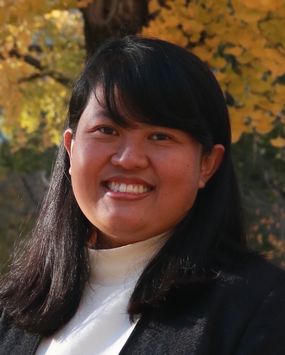 Karina Aprilia Sujatmiko
Karina Aprilia Sujatmiko
(Kansai University)
Hello! My name is Karina Aprilia Sujatmiko. My friend and colleague usually calling me by my nickname, Alin. I knew about Japan since I was a kid, through a pop culture like manga or anime. Why? Because kids in Indonesia, share a similar childhood memories of spending Sunday morning by watching Doraemon in the national television. I learned more about Japan when I was an undergraduate student in Bandung Institute of Technology, majoring in Oceanography. My thesis was about tsunami in West Java that happened in 2006. In Indonesia, the term tsunami was relatively new, mostly knew about tsunami after the catastrophic event of 2004 Aceh tsunami. So, I learned a lot from past tsunami happened in Japan.
In 2018, a tsunami occurred in Palu. At that time, I was a junior lecturer at Bandung Institute of Technology (ITB). Around two weeks after the tsunami I went to do a post-tsunami survey in Palu. This was a joint survey between, Indonesian and Japan. It was during this survey I met my future supervisor. His name is Yoshihiro Okumura from Kansai University. After the survey, I contact him, and I said that I want to study more about tsunami. Fortunately, with his help, I get a MEXT scholarship to take a doctoral degree at Program of Disaster Management in Faculty of Societal Safety Sciences.
I was the first foreign doctoral student at this program. All members in my laboratory are Japanese students. Even though there is a language barrier, we still can communicate very well and make a good friendship. I found Japanese student and professor here are nice and kind to me. Their warm welcome makes me enjoy my study in the laboratory more.
The pandemic situation has been very difficult to us. At least there are two things affected my research study. First is I couldn’t take sample in Indonesia due to the travel restriction. The data that I want to get is about people behavior during the tsunami evacuation. Together with my supervisor, we did a lot of brainstorming together and we found that we could use a footage during the disaster. The silver lining is we found a new method to analyze people behavior. Second, this travel restrictions also makes me unable to return to Indonesia which makes me homesick and worried about my family. Thanks to the technology today, this constraint can be overcome by phone and video call. Japanese awareness and good implementation of the safety procedure also eased my family's worries.
I am grateful that I do my research in Japan. I could see directly the efforts taken by Japanese government to reduce the risk of future disaster. I visited Sendai and Miyagi prefecture that was destroyed by the 2011 Great East Japan tsunami. I saw the massive wall built along the coastline; the uplifting of area almost as big as a town; and a numerous building dedicated for relocations. I also saw the yearly evacuation drill held in Minami Awaji Island. Together with sensei and the laboratory members, we analyze the resident behavior during this drill.
Since my first year in Japan, I become a JSCE member. I felt lucky to join the site visit of construction site organized by JSCE. First is Kita-Osaka Kyuko line extension project, the new subway that will be connected Senri-chou station to Minoh with the length of about 2.5 km. Second is the Ujitawara Tunnel, Ujitawara Second Viaduct and Joyo Viaduct on Shin-Meishin Expressway. I also joined the JSCE conference and published two of my papers in JSCE proceeding.
In this past two years, aside from the research study, I also learn and experienced Japanese culture. With my professor and my laboratory friends, we enjoyed Onsen and eat Japan cuisine. They are very considerate of me, since I’m a Muslim, they always make sure that we ate food suitable with my religion. I especially fond of Sushi, Unagi, Yakiniku and Takoyaki. Another thing that really mesmerizing for me is Japan nature. In her, the season changing present a different nuance of beauty. I find the pleasure of view and photographing the delicate of cherry blossom during spring, a vibrant color of momiji in autumn, and a breathtaking landscape of snow pile.
I’m grateful to get the scholarship from MEXT. I wish many people can study in Japan, not only to learn in academic field, but also Japanese culture and etiquette. I hope my relationship with Japan doesn’t just stop after I graduated but continue to flourish after I return to Indonesia.
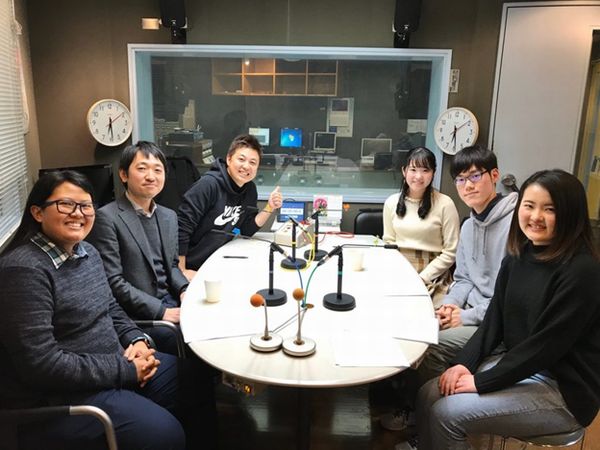
Sharing about Student Life and Research on the Radio Program
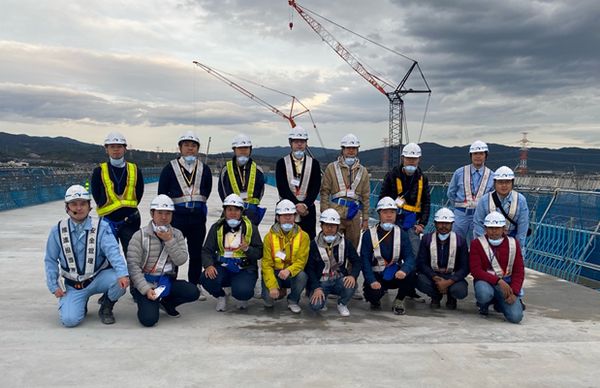
Visiting Construction Site Organized by JSCE on Shin-Meishin Expressway
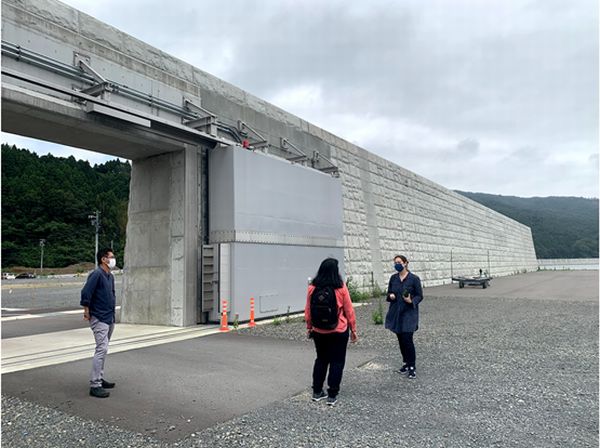
High Seawall as a Countermeasure to Protect the Surrounding Area, Built Along in Ogatsu Bay, Tohoku.
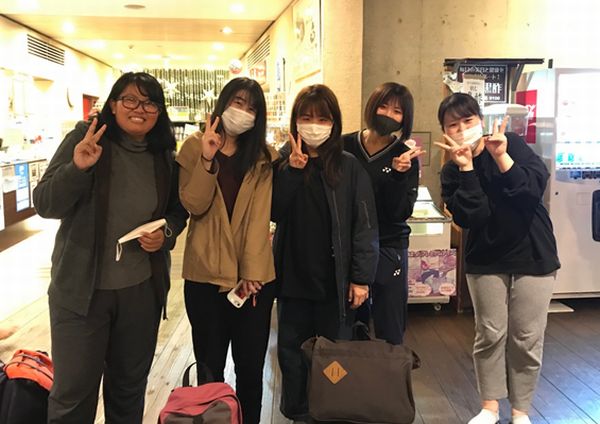
Went to Onsen together with Laboratory Members
【Reported by Reported by Karina Aprilia Sujatmiko, Kansai University】
Updates
◆The 5th Seminar on the Internationalization of Technical Standards(March 8)
https://committees.jsce.or.jp/kokusai/node/255
◆3rd JSCE Concrete Committee Webinar "Frontiers of Concrete Technology" (March 9)
https://www.jsce-int.org/node/745
◆JSCE Concrete Committee Newsletter No.64, January 2022
http://www.jsce.or.jp/committee/concrete/e/newsletter/newsletter64/index.html
◆The 9th Civil Engineering Conference in the Asian Region (CECAR9)
https://cecar9.com/
◆The Seventh Annual Multi-Stakeholder Forum on Science, Technology and Innovation for the SDGs
(STI Forum):https://sdgs.un.org/tfm/STIForum2022#call_for_inputs
◆American Society of Civil Engineers (ASCE)
・Joint Japan-US Symposium on Assessment, Management, and Governance for Infrastructure Resilience
*Pre-recorded Presentation Available on the Website.
https://www.infraresil.jp/event/01/
◆The 9th International Conference on Flood Management (ICFM9)
https://www.icfm9.jp/index.html
◆European Council of Civil Engineers E-Journal
http://www.ecceengineers.eu/newsletter/Files/ECCE-E-journal- 23.pdf?m=1640190118&
◆The International Infrastructure Archives
– A Compilation of Japan’s Greatest Projects in Transfer of Civil Engineering Technology in Service –
http://www.jsce.or.jp/e/archive/
- 【New Project】Male’ Seawall Project (Maldives)
http://www.jsce.or.jp/e/archive/project/pj14.html
◆IAC “News Pick Up!!” on the JSCE Japanese website
https://committees.jsce.or.jp/kokusai/iac_dayori_2021
◆Summary of featured articles in JSCE Magazine Vol. 107, No.2, February 2022
http://www.jsce-int.org/pub/magazine
◆Journal of JSCE
https://www.jstage.jst.go.jp/browse/journalofjsce
IAC News Subscription
The IAC News is one of the communication tools to share information and ideas with the members. We would like to invite you, your friends and colleagues to join the communication and to subscribe the IAC News. Please register online: (http://www.jsce-int.org/node/150). We look forward to meeting you.
